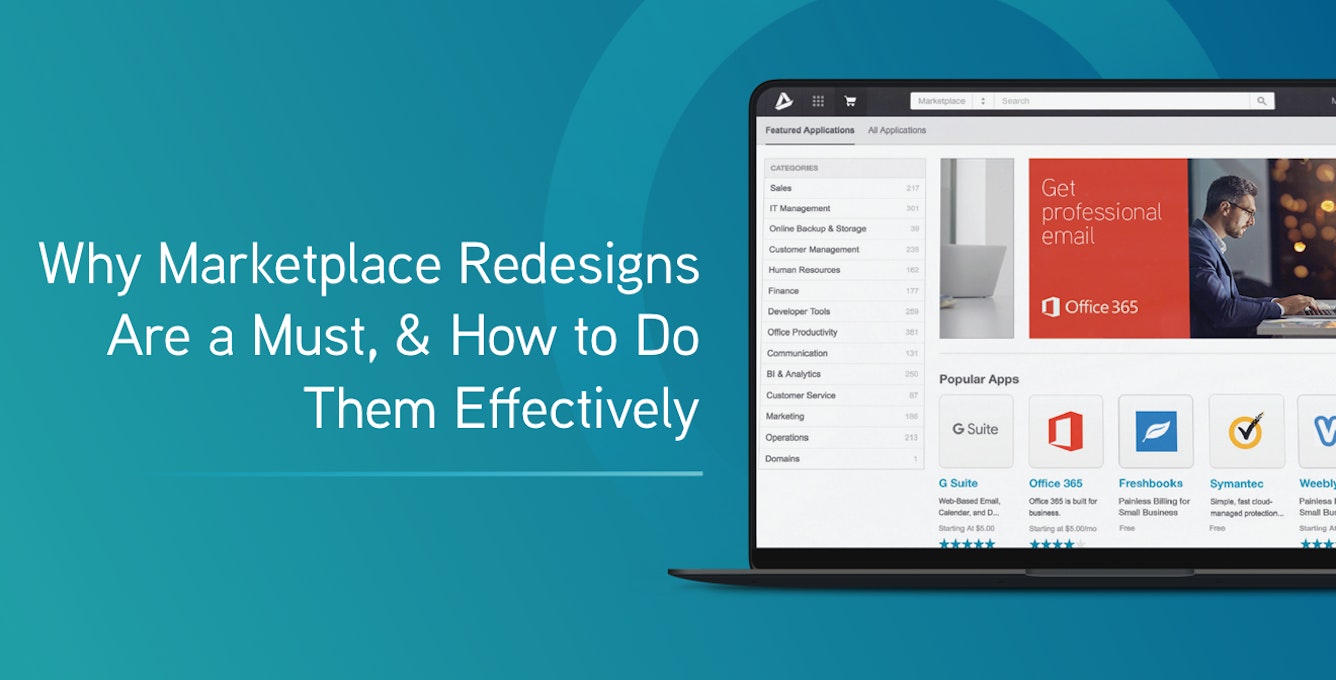Strategy & Best Practices
Why Marketplace Redesigns Are a Must, and How to Do Them Effectively
By Shideh Rahmanian / May 18, 2020

Business buyers have long been accustomed to slick digital experiences in their personal lives and that exposure is shaping their expectations of what commercial interactions should look like. If your marketplace does not offer an easy, intuitive shopping experience—like Amazon.com—customers will simply take their business elsewhere. Having the right product assortment in your marketplace is critical, but so is having the right content and presenting it in a way that enables discovery and purchase.
Designing and delivering these Amazon-like experiences can be challenging, often because platforms don't offer the necessary capabilities to fully customize your marketplace, and having the right tools can make all the difference. It’s a lesson I've learned firsthand as the manager for the AppDirect Add-On Store, a marketplace for complementary SaaS products and services. Because my Add-On marketplace is built on the AppDirect platform, I have total control over its look and feel. The range of developer and business user tools that are available allow me to deliver an experience that aligns tightly with my branding and business objectives.
But no matter your level of control, it can still be overwhelming. How do you even start redesigning your marketplace experience?
Having just gone through this process myself, I want to share with others a guide on how they can collaborate with their design team to define a totally new experience. Like my design team says: It’s about more than just making things pretty!
Discovery and Investigation First, Wireframe Second
To really nail your marketplace redesign it’s critical to go through discovery and investigation before a single wireframe is produced. This gives you a chance to collectively discuss, question, align, and brainstorm on the best path forward. Here’s how to do it, step by step.
1. Determine your objectives:
- What are you trying to achieve with this project and for when? Is this just phase one of a longer-term plan and what does that overall plan look like?
- Do you need to be mindful of other projects touching the marketplace like a move from a listing to a transactional marketplace?
- How will the size of your catalog affect the design of your marketplace? Are you taking a curated approach or do you have a large catalog that needs additional support for buyer discovery and navigation?
By being clear on your objectives and current versus future state, you can help identify which resources are required to complete the project (e.g., strictly design or web development as well) and plan appropriately.
2. Think about your audiences and entry points:
- Who is coming to your marketplace? Just buyers and partners? Sales reps? Industry analysts?
- Why are they coming? What kind of information is each audience type looking for?
- Where are they coming from? How did they learn about your marketplace and what background/ familiarity do they have with you and your products before they land there?
- What action do you want each audience type to take?
- Do the audience types know what they’re looking for or do we need to educate them? And how? How do your customers think and categorize these products and would your browsing / navigation experience support that? What are other attributes they’d want to understand?
Having a good understanding of your audience is critical to deciding what types of content and features you need in your marketplace, and more importantly, the weight and order of messaging. Don’t forget to activate those Google Analytics tags!
3. Find your existing gaps:
- For each audience type, what pains do they have with your marketplace today?
- What features or enhancements would help them take the desired action?
You’re probably very close to your marketplace and have a good idea of where there’s opportunity for obvious improvements. Consider speaking directly with different audience types to understand gaps from their perspective.
4. Benchmark your marketplace against the competition
- What do other marketplaces look like? What do you like or dislike about them in terms of visual treatment, navigation, etc.?
Use research as a way to pull in best practices from brands and marketplaces you know and respect. Consider how the nature of products (e.g., price points, decision-making process, etc.) in their marketplace might differ from yours, and how that might affect the design.
5. Determine your content and narrative
- What is the story you want to tell on your home page and what kind of content will support this?
- Do you have strategic or preferred partners that you want to spotlight?
- Do you have customer evidence and success stories that are worth highlighting?
The answers to the above questions affect not just the content but the navigation of your home page, sub-pages, and even the product profiles.
There Are No Shortcuts
While you’re probably itching to get your eyes on some mocks, a thorough discovery process should span a few weeks, giving you and your colleagues a chance to discuss and ideate. Taking the necessary time upfront will almost guarantee that the end result will be a marketplace that reflects the unique experience you want to deliver.
Interested in enhancing your customer's experience with complete front-end customization of a digital marketplace? Watch our on-demand webinar to learn how:
Shideh Rahmanian is a Senior Product Marketing Manager at AppDirect.
Related Articles

Strategy & Best Practices
How to Create a Better Marketplace Experience with Composable Commerce
Composable commerce is redefining how marketplaces engage customers and partners by delivering unmatched personalization and agility. Learn how to use headless APIs, extensions, and automation to create standout, flexible commerce experiences that keep you ahead of the competition.By Jonmichael Moy / AppDirect / November 26, 2025

Strategy & Best Practices
Get Comfortable Talking Security with Your Customers
A practical guide for tech advisors to confidently engage in cybersecurity conversations, understand risks, and support customers with essential security knowledge and resourcesBy Denise Sarazin / AppDirect / August 22, 2025

Strategy & Best Practices
Grow Your Revenues Through New Routes to Market
Explore four proven strategies to broaden your routes to market, sell more effectively into the SMB market, and achieve maximum revenue growthBy Denise Sarazin / AppDirect / August 21, 2025